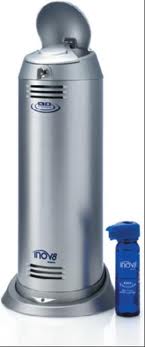
Problem being addressed
Air is a major source of transmission for TB and other healthcare associated infections. The Inov8 Air Disinfection Unit is designed to rapidly mitigate the spread of healthcare associated infections by filtering air within an enclosed space to kill air borne bacteria, viruses, and fungi to almost undetectable levels.
Detailed description of the solution
The Inov8 Air Disinfection Unit is a portable device that uses hydroxyl radicals to recreate the natural germ-killing properties of fresh air. This product requires a refill cartridge that contains limonene, which is a byproduct of orange juice. Hydroxyl radicals deactivate bacteria and viruses such as tuberculosis. Within an hour of turning on the Inov8 Disinfection Unit, the device can reduce 99.99% of bacteria and viruses within the room. Each cartridge can continuously purify air for approximately three months. People can be in the room while the product operates as the device is designed for spaces in which people live.
Designed by
- Design: The design was based on technology resulting from the research at the UK's Ministry of Defense. The product was designed, made, and manufactured by Aerte.
- Manufacturing: This device is made in London, England.
When and where it was tested/implemented
The Inov8 Air Disinfection Unit was tested and launched in the United Kingdom and Jeddah, Saudi Arabia. It has also been introduced in the United States and is available in India.
References
Peer-reviewed publication
Beggs, C.B., Kerr, K.G., Donnelly, J.K., Sleigh, P.A., Mara, D.D., & Cairns, G. 2000. The resurgence of tuberculosis in the tropics. An engineering approach to the control of Mycobacterium tuberculosis and other airborne pathogens: a UK hospital based pilot study. Royal Society of Tropical Medicine and Hygiene, 94(2), 141-6.
Ezbiri, A., Elen, R., & Leech, J. (2010). Review of current evidence on the reduction of infection rates in ten NHS hospitals using the Inov8 AD (air disinfection) technology. Journal of Hospital Infection, 76(10), 11-24.
Wong, V., Staniforth, K., & Boswell, T.C. (2010). Environmental Contamination and airborne microbial counts: a role for hydroxyl radical disinfection units. Journal of Hospital Infection, 78(3), 194-199.
Other internally generated reports
inov8. From Biological Defence to a Healthy Office Environment. May 2010. PDF available here.
Externally generated reports
Aerte Release: New Medical Device that Kills Airborne Pathogens. Link available here.
Aerte's main website for Technology & Design available here.
Smart Solutions for HCAI. NHS (2008). Putting the technologies to the test. Link available here.